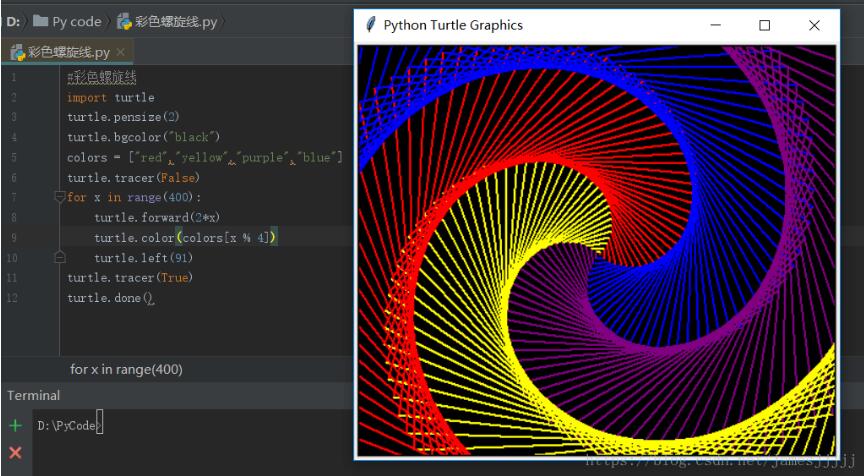Python实现时钟显示效果思路详解
语言:Python
IDE:Python.IDE
1.编写时钟程序,要求根据时间动态更新

2.代码思路
需求:5个Turtle对象, 1个绘制外表盘+3个模拟表上针+1个输出文字
Step1:建立Turtle对象并初始化
Step2:静态表盘绘制
Step3:根据时钟更新表针位置与时间信息
基本库:Turtle、datetime
3.代码段
from turtle import *
from datetime import *
def Skip(step):
penup()
forward(step)
pendown()
def mkHand(name, length):
#注册Turtle形状,建立表针Turtle
reset()
Skip(-length*0.1)
begin_poly()
forward(length*1.1)
end_poly()
handForm = get_poly()
#注册Turtle形状命令register_shape(name,shape=None)
register_shape(name, handForm)
def Init():
global secHand, minHand, hurHand, printer
mode("logo")# 重置Turtle指向北
#建立三个表针Turtle并初始化
#第二个参数为长度
mkHand("secHand", 125)
mkHand("minHand", 130)
mkHand("hurHand", 90)
secHand = Turtle()
secHand.shape("secHand")
minHand = Turtle()
minHand.shape("minHand")
hurHand = Turtle()
hurHand.shape("hurHand")
for hand in secHand, minHand, hurHand:
hand.shapesize(1, 1, 3)
hand.speed(0)
#建立输出文字Turtle
printer = Turtle()
printer.hideturtle()
printer.penup()
def SetupClock(radius):
#建立表的外框
reset()
pensize(7)
for i in range(60):
Skip(radius)
if i % 5 == 0:
forward(20)
Skip(-radius-20)
else:
dot(5)
Skip(-radius)
right(6)
def Week(t):
week = ["星期一", "星期二", "星期三",
"星期四", "星期五", "星期六", "星期日"]
return week[t.weekday()]
def Date(t):
y = t.year
m = t.month
d = t.day
return "%s %d %d" % (y, m, d)
def Tick():
#绘制表针的动态显示
#当前时间
t = datetime.today()
second = t.second + t.microsecond*0.000001
minute = t.minute + second/60.0
hour = t.hour + minute/60.0
secHand.setheading(6*second)
minHand.setheading(6*minute)
hurHand.setheading(30*hour)
#介入Tracer函数以控制刷新速度
tracer(False)
printer.forward(65)
printer.write(Week(t), align="center",
font=("Courier", 14, "bold"))
printer.back(130)
printer.write(Date(t), align="center",
font=("Courier", 14, "bold"))
printer.home()
tracer(True)
ontimer(Tick, 100)#100ms后继续调用tick
def main():
tracer(False)
Init()
SetupClock(160)
tracer(True)
Tick()
mainloop()
if __name__ == "__main__":
main()
补充:
Python实现时钟
1.小时钟获取当前时间并用打印在Console上
2.上代码
import time,sys,os
while(1):
t = time.strftime('%H:%M:%S',time.localtime(time.time()))
sys.stdout.write(t+'\b'*10)
sys.stdout.flush()
time.sleep(0.1)
os.system('cls')
3.解释
第一步:导入time,sys,os模块
第二部:实现无限循环
第三步:实现格式化输出,具体的详细使用方法,参见:这里
第四部:重定向到Console上
第五步:刷新
第六步:间隔0.1执行一次
第七步:清屏
